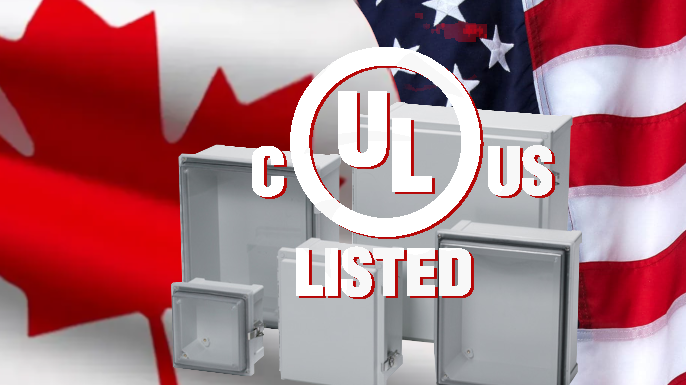UL and cUL Certified Plastic Enclosures
UL (Underwriters Laboratories) and cUL (Canadian Underwriters Laboratories) certifications are marks of safety and quality for products, particularly in the electrical and electronics industries. These certifications indicate that a product has met specific safety standards and regulations, ensuring the safety of users and the environment. In the world of product safety, UL, (Underwriters Laboratories) and cUL (Underwriters Laboratories of Canada) certifications are highly regarded and recognized globally. They provide assurance that a product has been rigorously tested and meets the necessary safety requirements, protecting both consumers and the environment from potential hazards.

Fibox offers a wide range of UL and cUL certified polycarbonate plastic enclosures that are designed to protect sensitive electronic and electrical components from the elements and other hazards. Fibox enclosures are made from high-quality materials and are built to withstand demanding environments.
Certification Processes
Obtaining UL and cUL certifications involves a series of steps that manufacturers must follow to ensure their products meet the required safety standards. While the processes for both certifications are similar, there are some differences that manufacturers need to be aware of.
Key Differences and Similarities
While both UL and cUL certifications are marks of safety and quality, there are some key differences between the two. Here, we will highlight the main differences and similarities:
-
Similarities: Both UL and cUL certifications are based on similar safety standards and testing protocols. They ensure that products meet stringent safety requirements, providing peace of mind to manufacturers and consumers alike.
-
Differences: UL certification is primarily used in the United States, while cUL certification is used in Canada. Additionally, cUL certification may require additional testing and evaluation to meet Canadian safety standards. This distinction is crucial for manufacturers who wish to market their products in both countries.
By understanding the certification processes and key differences between UL and cUL certifications, manufacturers can ensure that their products meet the highest safety and quality standards, providing peace of mind for residents and users around the world.
UL and cUL certification are essential for plastic enclosures used in a wide range of industries, including electrical, electronics, and medical. UL (Underwriters Laboratories) and cUL (Underwriters Laboratories of Canada) are independent safety science companies that test and certify products to ensure they meet rigorous safety standards.
Fibox offers a wide range of UL and cUL certified polycarbonate plastic enclosures that are designed to protect sensitive electronic and electrical components from the elements and other hazards. Fibox enclosures are made from high-quality materials and are built to withstand demanding environments.
Benefits of UL and cUL Certified Plastic Enclosures
Both UL and cUL certification are based on the same safety standards, but there are some minor differences in the requirements for specific products. Just like a cul de sac provides a safe and enclosed area for residents, UL and cUL certified enclosures offer a secure environment for sensitive components. For example, the cUL standard for electrical control equipment requires a higher level of protection against moisture than the UL standard, highlighting the specific requirements de cUL certification. UL and cUL certification provide a number of benefits to manufacturers and users of plastic enclosures:
-
Safety: UL and cUL certified enclosures have been tested to meet rigorous safety standards, ensuring that they will protect sensitive electronic and electrical components from hazards such as fire, electric shock, and water damage.
-
Compliance: UL and cUL certification is required by many regulatory agencies for products that are sold or used in the United States and Canada.
-
Peace of mind: UL and cUL certification provides peace of mind for manufacturers and users of plastic enclosures, knowing that their products are safe and compliant with applicable regulations.
Applications for UL and cUL Certified Plastic Enclosures
UL and CUL certified plastic enclosures are used in a wide range of applications, including:
-
Electrical control panels
-
Electronic devices
-
Outdoor enclosures
Choosing the Right UL and CUL Certified Plastic Enclosure
When choosing a UL and CUL certified plastic enclosure, there are a number of factors to consider, including:
-
Size: The enclosure must be large enough to accommodate the electronic and electrical components that will be housed inside it.
-
Material: Fibox enclosures are available in polycarbonate, this robust plastic is stronger than steel, but lightweight, rust-free and Wi-Fi friendly.
-
Ingress protection: Fibox enclosures offer a variety of ingress protection (IP) ratings, which indicate the level of protection against dust and water. The required IP rating will depend on the environment in which the enclosure will be used.
Conclusion Fibox offers a wide range of UL and CUL certified plastic enclosures that are designed to protect sensitive electronic and electrical components from the elements and other hazards. Fibox enclosures are made from high-quality materials and are built to withstand demanding environments.
Steps to Obtain cUL Certification
To obtain cUL certification, manufacturers must follow these steps:
-
Determine the applicable standards: Identify the relevant Canadian safety standards for the product. This step involves understanding the specific requirements that the product must meet to be considered safe for use in Canada.
-
Prepare the product: Ensure the product meets the requirements of the applicable standards. This may involve making design adjustments, selecting appropriate materials, and conducting preliminary testing.
-
Submit the application: Provide detailed information about the product, including its design, materials, and testing data. This documentation is crucial for the certification body to assess the product’s compliance with safety standards.
-
Undergo testing and evaluation: cUL will conduct testing and evaluation to verify compliance with the standards. This step involves rigorous testing to ensure the product performs safely under various conditions.
-
Obtain certification: If the product meets the standards, cUL will issue a certification mark. This mark indicates that the product has been certified as safe for use in Canada.
